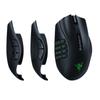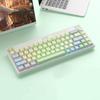1.Differences Between Optical Switches and Mechanical Switches, and Advantages of Optical Switches
Differences:
Working Principle:
Mechanical Switches: They rely on metal springs and contact points to sense key presses. When a key is pressed, the metal spring makes contact with the circuit, transmitting the signal.
Optical Switches: These utilize optical sensors to detect key activation through infrared light beams. When a key is pressed, the light beam is interrupted, thereby transmitting the input signal.
Durability:
Mechanical Switches: Standard mechanical switches typically have a lifespan of around 50 million presses, while some high-end versions can last even longer.
Optical Switches: Due to the absence of metal contact points, optical switches can achieve a lifespan of over 70 million presses, with certain models even reaching 100 million.
Advantages of Optical Switches:
Faster Response Time: Optical switches provide quicker input response, making them ideal for gaming as they can enhance reaction speed.
Increased Durability: The design of optical switches minimizes wear and tear, enhancing their longevity.
Immediate Feedback: Optical switches deliver instant signal feedback, which is crucial for applications needing rapid responses.
Quieter Operation: Linear optical switches are almost silent during use, making them suitable for quiet environments like offices or libraries.
2. Distinction Between Linear and Tactile Optical Switches
Linear Optical Switches:
Characteristics: These switches feature a smooth keypress with no tactile feedback, creating a seamless pressing experience without any bump.
Suitable For: Ideal for gamers due to their ability to provide rapid and continuous key inputs, as well as being quiet enough for use in quieter settings.
Tactile Optical Switches:
Characteristics: These switches include a distinct tactile bump in the middle of the keypress, allowing users to feel a change in the key's position, which may produce more noise.
Suitable For: Perfect for typists or users who prefer the traditional mechanical keyboard feel and appreciate tactile feedback.
Keyboard Features and Shortcuts:
1.Compatibility:
Compatible with Windows XP, Vista, 7, 8, and 10 operating systems.
2.Factory Reset:
Reconnecting the USB cable (powering on) will restore the keyboard to its factory default settings (no memory retained).
3.Multimedia Functions:
Fn + ESC: Reset the keyboard.
Fn + F1: Open My Computer.
Fn + F2: Initiate Search.
Fn + F3: Open Calculator.
Fn + F4: Multimedia control functions.
Fn + Win: Lock/Unlock Windows key.
4.Gaming Backlight Modes:
Fn + 1 (M1): LOL Mode (Illuminates specific keys: ESC, 1-7, Q-W-E-R-P-A-S-D-F, SPACE).
Fn + 2 (M2): FPS Mode (Illuminates W, A, S, D, LSHIFT, LCTRL, SPACE).
Fn + 3 (M3): 8-Key Mode (Illuminates W, A, S, D, and the arrow keys).
Fn + 4 (M4): 33-Key Mode (Illuminates keys Q through Z based on the pressed keys).
Fn + 5 (M5): Overwatch Mode (Illuminates specific keys including ESC, F1, 1-2, etc.).
5.Lighting Effects:
Toggle lighting effects using Fn + PRTSC (18 different lighting effects available).
6.Speed Adjustment:
Fn + Right Arrow: Increase dynamic lighting/breathing speed (5 levels).
Fn + Left Arrow: Decrease dynamic lighting/breathing speed (5 levels).
7.Backlight Brightness Adjustment:
Fn + Up Arrow: Increase brightness (5 levels, defaults to level 5).
Fn + Down Arrow: Decrease brightness (final level turns off the backlight).
8.Restore Factory Settings:
Long press Fn + ESC for 3 seconds; the main key area backlight will flash 3 times.
9.N Indicator Light Functionality:
0 = Insert Key (Ins)
Decimal Point = Delete Key (Del)
1 = End Key
3 = Page Down Key (PgDn)
7 = Home Key
9 = Page Up Key (PgUp)
Product size:398*140*37mm
Weight:1190g+20










































